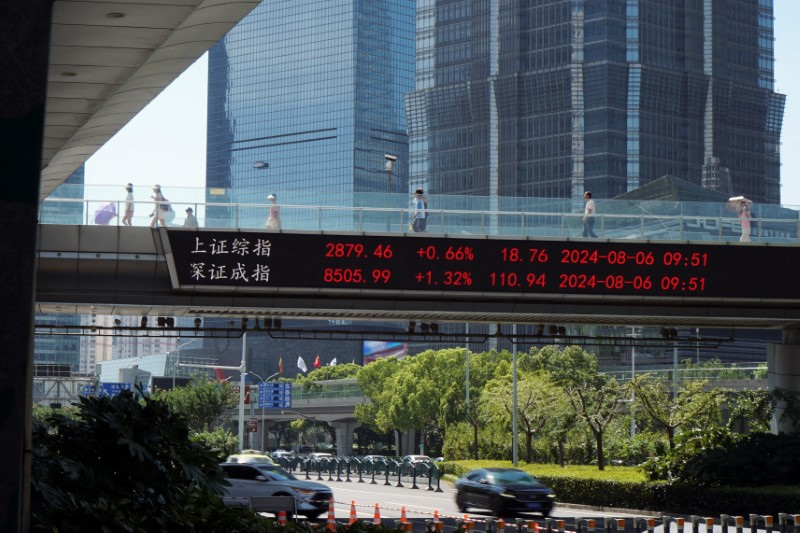Stocks regain stability as US retail report reassures
By Naomi Rovnick and Dhara Ranasinghe
LONDON (Reuters) - World stocks steadied on Thursday after weeks of wild swings and Wall Street was set for a bounce, as strong U.S. retail sales data healed some of the pain inflicted on markets this summer by a shock Bank of Japan rate hike and economic growth scares.
MSCI's world share index, which has moved in excess of 1% on more than half of the trading days in August so far, traded flat.
U.S. S&P 500 share index rose 1% in early dealings and the VIX equity volatility gauge eased to its lowest point of the month, having soared to a four-year high on Aug. 5.
The dollar gained 0.5% against other major currencies, halting a stretch of losses that took it to its lowest per euro on Wednesday since late 2023 and have sent it down almost 15% against Japan's yen since early July.
The semblance of calm returned to markets, roiled last week by price falls, volatility and intense hedge fund selling, after a U.S. retail sales report indicated consumer spending had been resilient, allaying fears of an imminent recession.
This followed U.S. inflation data on Wednesday that also reinforced bets for a September U.S. rate cut.
The Federal Reserve has held its main funds rate at 5.25%-5.5% for more than a year, helping to quell consumer price rises but also exacerbating some market imbalances that erupted into chaos this summer.
A sustained period of high U.S. rates driving the dollar higher against Japan's yen screeched to a halt in July, creating a wrecking-ball effect on a popular speculative trade that involved borrowing the Japanese currency to buy U.S. stocks.
A vicious unwinding of this so-called carry trade sparked a market rout last week, although many investors believe the currency-related disruption is almost over.
"I don’t this (has been) a long-term wider market correction," said James Henderson, equity fund manager at Janus Henderson.
Wall Street's tech-focused Nasdaq 100 index , believed to have been a beneficiary of carry flows because it has moved inversely to the yen's gains and losses against the dollar, has gained 3.4% in the last five trading sessions.
U.S. tech stocks remained over-valued, Henderson said.
"However, the median numbers show that valuations beyond these leaders are not so demanding, particularly if rates are coming down," he added.
STILL WARY
Nordea chief market analyst Jan von Gerich said that the speed of the Wall Street bounce-back was a reason to be wary of further volatility ahead.
"The tentative rebound in risk appetite has happened surprisingly fast, so I would be cautious," he said.
Reflecting ongoing anxiety, the spot gold price rose 0.3% to $2,458 per ounce, close to its July 17 all-time high.
Big investors are also now the most pessimistic about global growth than they have been all year, a Bank of America survey showed on Tuesday.
Following a surprisingly weak U.S. jobs report in early August, Thursday's retail sales numbers had the potential to set more alarm bells ringing, IG market analyst Tony Sycamore said.
After that retail data, money markets were still fully pricing a Fed rate cut in September, with a 25 basis point (bp) reduction viewed as most likely and traders also placing a 24% probability on a 50 bps cut.
Elsewhere in markets, sterling slipped 0.3% to $1.2849 even after data showed Britain's economy grew 0.6% in the second quarter of 2024, which was in line with economists' expectations.
The UK's domestically-focused FTSE 250 share index gained 0.2%, having risen for six of the last eight sessions and staying close to a two-year high.
European and U.S. government bond yields rose on Thursday as prices of the debt securities slipped to reflect the improvement in appetite for riskier equities.
The benchmark 10-year Treasury yield , at 3.93% and up 11 bps on the day, remained more than 40 bps lower since early July.
Oil markets were also strong on Thursday, with Brent crude , the international benchmark, 0.8% higher at $80.38 a barrel as the U.S. retail report brightened the outlook for global demand.
Source: Investing.com
